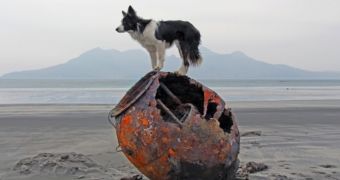A giant iron ball that washed ashore near Eigg island, in Scotland, was believed to be innocuous by locals but turned out to be a massive World War II mine possibly packed with explosives.
For years, families in the Hebridean island’s Laig Beach area thought the iron ball was just a flotation device, so they let their children play on it and even lit fires and barbecues around it as they picnicked nearby.
However, after winter storms blew the sand away, resident Ben Cormack realized that what everyone believed it was just a harmless buoy was, in fact, a huge wartime mine with its full explosive casing intact.
“The winter storms removed about a foot [30 cm] of the sand’s depth and revealed what looked like a sea mine. It was a bit of a worry because it was only a stone’s throw away from my dad’s front door,” Mr. Cormack said, according to the Mirror.
He alerted the police by sending it a picture of the huge beached object, and a bomb disposal team rushed to the site to evaluate the situation. Navy Bomb Disposal Unit confirmed the metal object was actually a dangerous Second World War mine and immediately evacuated nearby homes, including Ben Cormack's dad's house, which is located 100 yards (91.44 meters) from the beach.
“The barrel shaped metal object, that had been buried in the beach for as long as I can remember, had always been presumed to be an old wartime buoy, of which there were many on the Eigg beaches when I was a kid,” Ben, a 32-year-old graphic designer, added.
At a first glance, officials estimated that the huge bomb would contain around 300 pounds (136 kg) of high explosives, so they ordered controlled explosions to be carried out on the site. However, at a closer examination, they discovered the casing was actually full of sand, not explosives.
But to be 100% sure and to prevent unfortunate incidents from happening, the team performed several small controlled explosions to break the mine apart, Mr. Cormack mentioned.
“The mine was a British one used to protect Allied shipping lanes in World War II from German U-boats and warships. It’s a rare example as they are not usually found with the explosive casing still intact. That’s why they were very worried,” he said.
Ben Cormack was praised by Stornoway Coastguard officials for his involvement in the operation. “The guy did good. He realized that even after all these years this was something more than people thought it was and he was right,” a spokesperson said.

 14 DAY TRIAL //
14 DAY TRIAL //